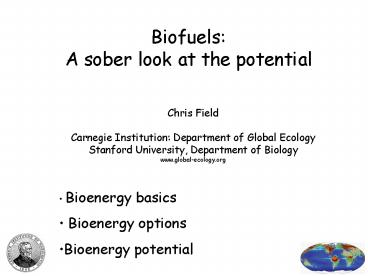Biofuels: A sober look at the potential - PowerPoint PPT Presentation
1 / 35
Title:
Biofuels: A sober look at the potential
Description:
Burning 1 lb of coal produces 3.6 lb of CO2. Burning 1 gal of gas produces 18 lb of CO2 ... The corn required to fuel one car on corn ethanol. Would feed 25 ... – PowerPoint PPT presentation
Number of Views:22
Avg rating:3.0/5.0
Title: Biofuels: A sober look at the potential
1
BiofuelsA sober look at the potential
- Chris Field
- Carnegie Institution Department of Global
Ecology - Stanford University, Department of Biology
- www.global-ecology.org
- Bioenergy basics
- Bioenergy options
- Bioenergy potential
2
Why biofuels?
- Climate protection
- Offset fossil fuels
- Account for fossil fuels used to produce
- Account for site carbon balance
- Account for other greenhouse gases
- Energy security
- Local potential
- Diversify sources
3
How can biofuels be lower carbon?
- Photosynthesis
- Light CO2 plant O2
- Plant combustion
- Plant O2 energy CO2
- Net
- Light CO2 energy CO2
4
How Biomass is Used for Energy
In development
Mature
Semi-mature (Capital intensive ineficient)
5
Carbon cycle basics
- Fossil fuel oxygen ? carbon dioxide
- Coal C O2 ? CO2
- Oil C8H16 12O2 ? 8CO2 8H2O
- Natural Gas CH4 3O2 ? CO2 2H2O
- How much CO2?
- Burning 1 lb of coal produces 3.6 lb of CO2
- Burning 1 gal of gas produces 18 lb of CO2
- The average person produces 30 lb CO2/day
- The average American produces 170 lb CO2/day
6
Setting the scale
- Food for 1 person for one year
- 250 kg corn
- ethanol for one fill-up
- 80 l (20 gal)
- At 25 mpg and 10,000 miles/y
- The corn required to fuel one car on corn ethanol
- Would feed 25 people
7
QUAD
BTU
1 kJ
1 MJ
1 GJ
1 TJ
1 PJ
1 EJ
1 YJ
1 ZJ
1 J
Energy
Powers of ten
0
3
6
9
12
15
18
21
24
8
Today, the world consumes 20X as much energy as
in 1900!
9
Future energy needsMany times current
10
Global annual plant growth
- 57 x 109 ton C on land
- 57 x 109 ton C in the oceans
2500 EJ or 5 x global primary energy
2500 EJ or 5 x global primary energy
11
Energy in ag and pastures?
Global Primary Energy 450 EJ/y In ½
biomass (to allow for roots), assume 45 C
12
Will yields increase dramatically?
- Historical trends a century of success
- 1-2/y for major crops
- Will this continue?
- Can it accelerate?
13
Ag yields a century of successincreases of
1-2 y-1
Lobell and Field ERL 2007
14
Limiting factors for global NPP
Baldocchi et al. 2004 SCOPE 62
15
Potential yield
- Ag in relation to natural NPP
- Ag/NPP -- Globally about 65
- Global average crop yields unlikely to exceed
natural NPP for at least the next several decades
16
Burn or Ferment?
- If you want energy
- Burn
- If you want oil independence
- Liquid biofuels
- Battery technology
17
Net energy balance ratio(biomass energy
out/fossil energy in)
- Corn ethanol 1.2
- Sugarcane ethanol 8
- Soy biodiesel 2
- Palm biodiesel 9
- Cellulosic 5(?)
18
Hill et al PNAS 2006
19
Is sugarcane the answer?
- High yields in warm, wet climates
- Limited need for fossil energy
- Burn bagasse for processing energy
20
Fargione et al. Science 2008
21
Is cellulosic the answer?
Yield of 26.5 tons/acre in limited area test plots
Courtesy of Steve Long et al
22
Lignin occludes polysaccharides
Cellulose
Hemicellulose
Lignin
23
Effect of lignin content on enzymatic recovery of
sugars from Miscanthus
cellulose
Hemi cellulose
Switchgrass composition
D Vrije et al (2002) Int J Hydrogen Energy 27,1381
24
Biofuels and food
USDA Amber Waves 2007
25
(No Transcript)
26
(No Transcript)
27
Ethanol production cost per tonCO2 equivalent
emissions offset(not accounting for land use)
Thow Warhurst, 2007 (divide by 2.2 for
break even oil price in /bbl)
28
Food the perfect storm?
- Population
- Food preferences
- Climate change
- Biofuels
29
Bioenergy the climate protective domain
- Increase growth
- Increase efficiency of conversion to useful
products - Utilize sites where C loss from conversion is
small in relation to bioenergy yield - Utilize sites that are not needed for something
else
30
Field, Campbell, Lobell TREE 2008
31
(No Transcript)
32
Field, Campbell, Lobell TREE 2008
33
Potential from abandoned land
Field, Campbell, Lobell TREE 2008
34
From available abandoned land
0.8 Pg C x 2 g Plant/g C x 0.5 g top/g plant x 16
EJ/Pg 13 EJ 3 of current global energy system
35
Bioenergy
- Climate impact depends on pre-existing ecosystem
- Indirect as well as direct paths to carbon loss
- Natural NPP reasonable proxy for potential yield
under ag management - Available land resource limited
- Quantity and quality
- Big potential in absolute terms
- But a small slice of present or future demand

